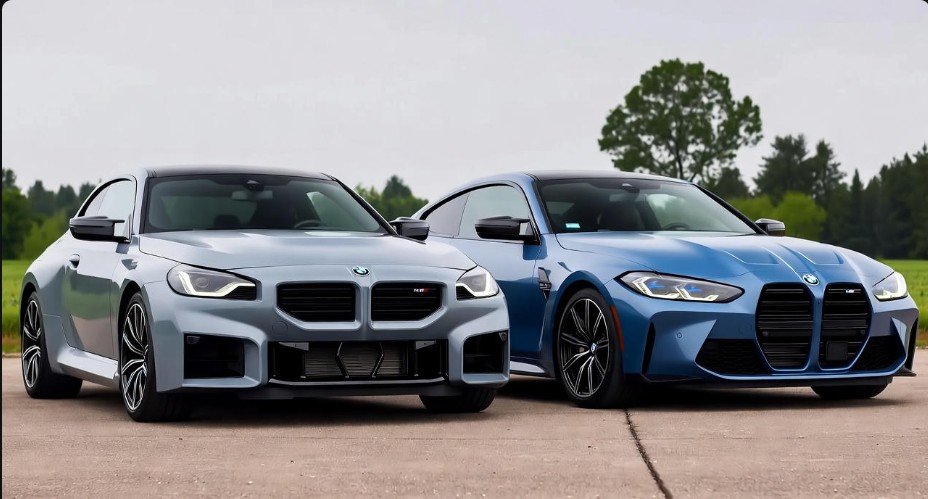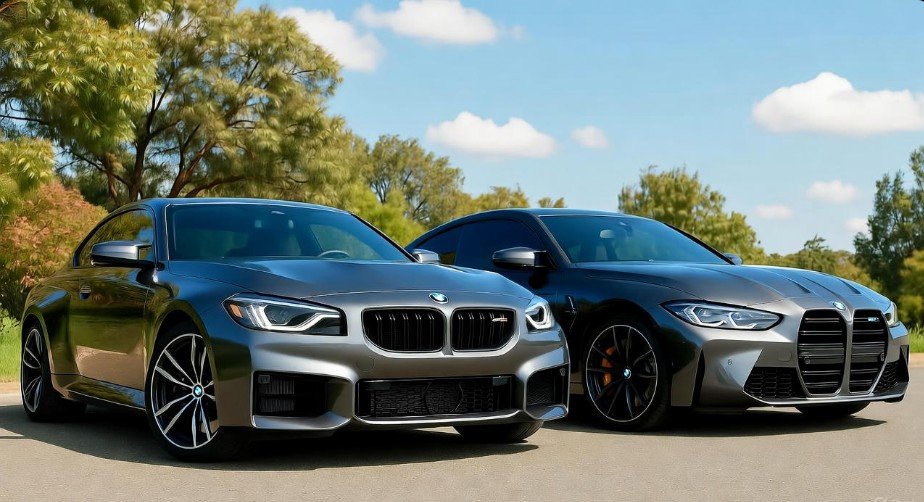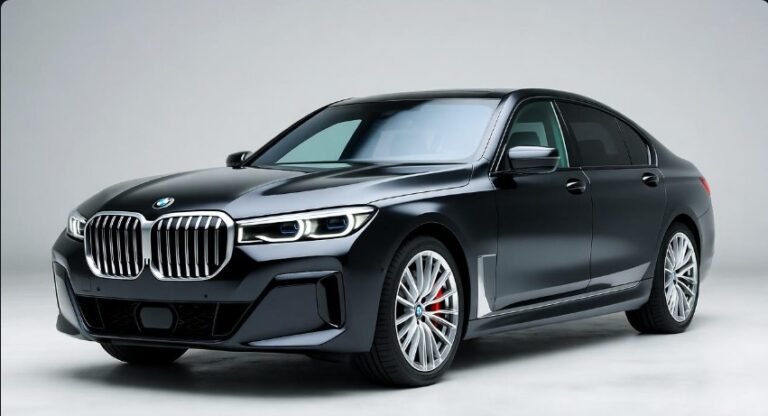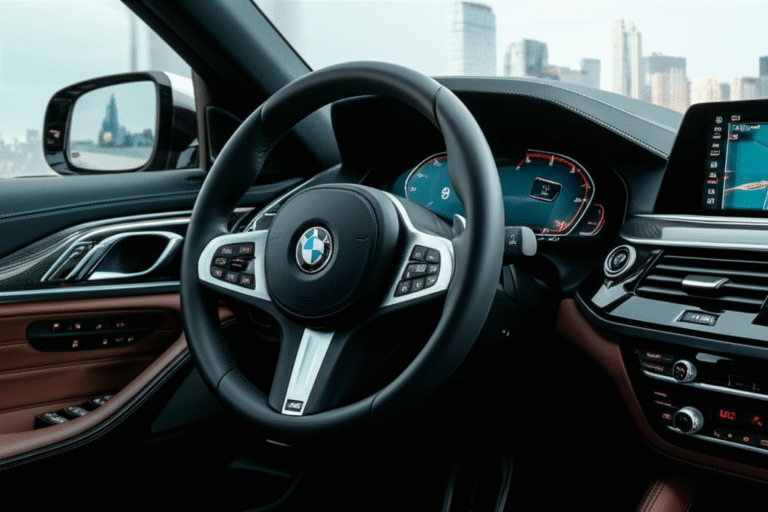BMW M2 vs M4: 6 Key Differences You Must Know

BMW M2 vs M4: 6 Key Differences You Must Know
When looking at BMW’s M performance division, the M2 and M4 often spark debate. Understanding the BMW M2 vs M4: 6 Key Differences You Must Know is crucial for enthusiasts and potential buyers. This guide breaks down what sets these two iconic performance machines apart, helping you make an informed decision.
Key Takeaways
Discover the M2’s agility against the M4’s refined power.
Compare their engine specifications for performance insights.
Analyze seating and cargo space for practical use.
Understand the distinct driving dynamics and handling.
Examine price points and value for your investment.
Identify which model best suits your driving style.
Choosing between two highly capable performance cars from BMW’s M division can be a delightful challenge. You might be drawn to the compact sportiness of the M2 or the more established prowess of the M4. Both offer thrilling drives and advanced engineering, but they cater to slightly different desires and driving philosophies. It’s easy to get lost in the performance figures and luxury features, making it confusing to pinpoint the true distinctions. Fear not! We’re here to simplify the comparison, laying out the 6 key differences between the BMW M2 and M4 in a clear, easy-to-understand way. Let’s dive into what makes each of these M cars a legend in its own right.
Understanding the BMW M2 vs M4: A Performance Divide

At their core, both the BMW M2 and the M4 are born from the same performance lineage. They represent BMW’s dedication to creating driver-focused machines that blend everyday usability with track-ready capability. However, their design philosophies and target audiences diverge in significant ways, leading to distinct characteristics. The M2 is often seen as the spiritual successor to the classic BMW 2002 Turbo, emphasizing a raw, engaging driving experience in a more compact package. The M4, on the other hand, evolves from the legendary M3 coupe lineage, offering a more potent blend of luxury, technology, and outright power, typically in a larger, more versatile chassis. Understanding this fundamental difference in approach is your first step in appreciating the M2 vs M4 debate.
1. Size and Chassis: Compact Agility vs. Gran Turismo Capability
One of the most apparent differences between the BMW M2 and M4 lies in their physical dimensions and the underlying chassis architecture. This impacts everything from handling dynamics to interior space.
BMW M2: The Nimble Compact Champion
The M2 is built upon BMW’s smaller coupe platform, typically the 2 Series. This results in a shorter wheelbase and a more compact overall footprint.
- Shorter Wheelbase: Contributes to quicker turn-in and a more agile feel in tight corners and spirited driving.
- Lighter Weight: Generally, the M2 weighs less than the M4, enhancing its responsiveness and power-to-weight ratio.
- Tighter Interior: While comfortable for two, the rear seats are significantly more cramped, and cargo space is more limited. It’s a true sports coupe in its proportions.
BMW M4: The Larger, More Potent Grand Tourer
The M4 is based on BMW’s larger 4 Series platform, which shares its architecture with the M3 sedan.
- Longer Wheelbase: Provides increased stability at higher speeds and contributes to a more composed ride, especially on the highway.
- Larger Footprint: Offers more interior room, particularly for rear passengers, and a more generous trunk.
- More Refined Ride: While still performance-oriented, the M4 often offers a slightly more comfortable and refined ride due to its larger dimensions and potentially more sophisticated suspension tuning.
The choice here often comes down to your priorities. If you crave razor-sharp reflexes and a more intimate connection with the road, the M2’s compact nature is alluring. If you need more practicality, a comfortable touring capability, and a bit more space for passengers or luggage, the M4 makes a strong case.
2. Engine and Performance Specs: Power Delivery and Character
While both vehicles boast potent engines developed by BMW M GmbH, they differ in their architecture, power output, and overall character.
BMW M2: Focused Power
The M2 typically employs BMW’s S58 twin-turbocharged inline-six engine, often in a slightly detuned state compared to its M4 sibling.
- Engine Configuration: Inline-six, twin-turbocharged.
- Power Output: While variations exist across model years and generations, the M2 generally offers slightly less horsepower and torque than the M4, focusing on delivering thrilling acceleration in a smaller package. For instance, the current G87 M2 generation boasts impressive figures, but may trail the M4’s top trims.
- Performance Focus: The M2’s engine is tuned to feel incredibly responsive and eager, making it a blast for spirited driving.
BMW M4: Unleashed Potency
The M4 also utilizes the S58 twin-turbocharged inline-six engine but in its more potent configurations.
- Engine Configuration: Inline-six, twin-turbocharged.
- Power Output: The M4 consistently delivers higher horsepower and torque figures, especially in its Competition and higher trims. This translates to more potent acceleration and higher top speeds.
- Performance Focus: The M4’s engine provides relentless power delivery, making it a formidable machine for outright speed and effortless overtaking.
Table 1: Engine Specifications Comparison (Illustrative – Specifics Vary by Model Year)
| Feature | BMW M2 (e.g., G87) | BMW M4 (e.g., G82/G83) |
|---|---|---|
| Engine Type | 3.0L Inline-Six, Twin-Turbocharged | 3.0L Inline-Six, Twin-Turbocharged |
| Horsepower (approx.) | 453 hp | 503 hp (Competition) |
| Torque (approx.) | 406 lb-ft | 479 lb-ft (Competition) |
| Transmission Options | 8-speed M Steptronic, 6-speed Manual | 8-speed M Steptronic, 6-speed Manual (RWD) |
When comparing the BMW M2 vs M4 in terms of sheer grunt, the M4 typically holds the advantage. However, the M2’s engine is no slouch and provides an exhilarating experience that perfectly matches its more compact chassis.
3. Drivetrain Options: RWD Purity vs. M xDrive Versatility
The drivetrain is a critical component defining how these cars put their power down and how they feel on the road. Both offer exciting options, but the M4 often provides more versatility.
BMW M2: Rear-Wheel Drive Focus
Historically and in its most recent generation, the M2 has been primarily offered with rear-wheel drive (RWD). This purist approach appeals to driving enthusiasts who value traditional handling characteristics and the ability to drift.
- RWD Dynamics: Offers a more direct and engaging driving experience, allowing for precise control over the car’s attitude.
- Simpler Architecture: Generally lighter and less complex than AWD systems.
BMW M4: RWD and M xDrive Availability
The M4, especially in its latest iterations, often provides a choice of drivetrains.
- RWD Option: For those who prefer the classic BMW M feel, RWD variants are available.
- M xDrive (All-Wheel Drive): Many M4 models come with M xDrive, BMW’s intelligent all-wheel-drive system. This system can often be configured to send power primarily to the rear wheels (2WD mode), offering the best of both worlds – enhanced traction and stability when needed, and RWD engagement when desired. This makes the M4 more adaptable to various conditions and driver preferences.
The availability of M xDrive in the M4 adds a significant layer of versatility. It can enhance performance in wet weather and provide lightning-fast acceleration, while still allowing for a pure RWD experience. If all-weather capability and ultimate traction are important, the M4 with M xDrive has a clear advantage.
4. Interior Design and Practicality: Seating and Cargo Space
The differences in their exterior size directly translate to variations in interior space and practicality between the M2 and M4.
BMW M2: Driver-Centric Cockpit
The M2’s interior mirrors its exterior – focused and sporty, with practicality taking a backseat.
- Front Seating: Offers excellent supportive seats for the driver and front passenger.
- Rear Seating: The rear seats are best suited for occasional use or for smaller passengers. Legroom and headroom are tight, making them less ideal for long journeys.
- Cargo Space: The trunk is smaller, limiting its utility for extensive luggage or larger items.
BMW M4: Spacious and Sophisticated Cabin
The M4’s interior offers a more comfortable and versatile experience, aligning with its grand touring aspirations.
- Front Seating: Features high-quality, supportive seats, often with more adjustment options.
- Rear Seating: Provides more usable rear seating space, making it more comfortable for adults on longer trips, though still not as cavernous as a dedicated sedan.
- Cargo Space: The M4 generally offers a larger and more practical trunk, better suited for carrying luggage for longer trips or for everyday utility.
Table 2: Practicality Comparison
| Feature | BMW M2 | BMW M4 |
|---|---|---|
| Seating Capacity | 4 (2+2 configuration) | 4 (more usable rear seats than M2) |
| Rear Legroom | Limited | More accommodating |
| Trunk Volume (approx.) | Less than M4 | More generous |
| Overall Interior Feel | Sporty, driver-focused | More spacious, refined |
If you frequently carry passengers or need significant cargo capacity, the M4’s practicality will be a deciding factor. The M2 is more of a personal performance coupe.
Pro Tip:
Consider the climate you drive in. If you encounter frequent rain or occasional snow, the M4’s M xDrive option offers a significant advantage in all-weather performance and safety.
5. Driving Dynamics and Handling: Raw Engagement vs. Refined Stability
This is where the heart of the BMW M2 vs M4 debate truly lies. The feel behind the wheel is distinct, reflecting their differing philosophies.
BMW M2: The Pure Driver’s Car
The M2 is engineered for an unadulterated, engaging driving experience. Its compact size and RWD bias make it incredibly agile and communicative.
- Telepathic Steering: Often praised for its direct and precise steering feel, allowing you to place the car exactly where you want it.
- Agile Handling: The shorter wheelbase and lighter weight contribute to sharper turn-in and a more playful, dynamic character. It feels more nimble and eager to change direction.
- Raw Feedback: Drivers often report more visceral feedback from the chassis and suspension, creating a more connected feel to the road.
BMW M4: Balanced Performance and Comfort
The M4 offers a more sophisticated blend of performance and refinement, making it incredibly capable yet comfortable for longer distances.
- Stable at Speed: Its longer wheelbase and wider track provide excellent stability, especially at high speeds and during high-G cornering.
- Compliant Ride: While firm and performance-tuned, the M4’s ride can be more compliant than the M2’s, making it a better daily driver for some.
- Advanced Suspension: Often features more advanced adaptive suspension systems that can better balance sporty handling with everyday comfort.
For those who prioritize a raw, analog connection to the driving experience and love to hustle a car through twisty roads, the M2 often wins hearts. The M4 provides a deeply satisfying performance experience that is also remarkably refined and capable across a broader range of driving scenarios.
6. Price and Value Proposition: Investment and Accessibility
The cost of entry and the overall value proposition are crucial considerations when comparing the BMW M2 vs M4.
BMW M2: The More Accessible M Performance
The M2 typically comes in at a lower starting price than the M4, making it a more accessible entry point into BMW’s M performance lineup.
- Lower MSRP: Generally, the M2 is more affordable, making it an attractive option for those seeking M performance without the premium price tag of the larger models.
- High Performance-to-Price Ratio: Offers a significant amount of performance and M-car DNA for its cost.
BMW M4: The Premium Performance Offering
The M4, being a larger, more powerful, and often more technologically advanced vehicle, commands a higher price point.
- Higher MSRP: The M4’s starting price is higher, reflecting its enhanced features, larger size, and more potent engine.
- Greater Customization: Often offers a wider range of optional packages and individual options, allowing for greater personalization but also increasing the final price.
- Long-Term Value: For some, the M4’s blend of performance, luxury, and practicality offers a more comprehensive value proposition for long-term ownership.
When considering the BMW M2 vs M4 on price, the M2 is the clear winner for budget-conscious performance enthusiasts. However, the M4’s higher price reflects its superior capabilities in certain areas, such as outright power and interior space. It’s about finding the best fit for your budget and your needs. You can explore current pricing and configurations directly on the BMW USA website.
Frequently Asked Questions (FAQ)
What is the main difference between BMW M2 and M4?
The primary difference lies in their size and performance focus. The M2 is a more compact, agile, and driver-focused sports coupe, while the M4 is a larger, more powerful, and refined performance grand tourer with more practicality.
Is the BMW M2 or M4 faster?
Generally, the BMW M4, particularly in its Competition variants, is faster in terms of straight-line acceleration and top speed due to its more powerful engine and more advanced drivetrain options like M xDrive.
Which car is more practical for daily driving: M2 or M4?
The BMW M4 is typically more practical for daily driving. It offers more interior space, especially for rear passengers, and a larger trunk, making it better suited for carrying passengers and cargo.
Can the BMW M2 seat four adults comfortably?
While the M2 has four seats, the rear seats are quite cramped. They are best suited for children or occasional use by adults on short trips. The M4 offers more comfortable seating for four adults.
Which car offers a more engaging driving experience, M2 or M4?
Many enthusiasts consider the M2 to offer a more raw and engaging driving experience due to its smaller size, lighter weight, and more direct feedback. The M4 is also incredibly engaging but delivers its performance with a layer of refinement and stability.
Is the BMW M2 cheaper than the M4?
Yes, the BMW M2 typically has a lower starting price than the BMW M4, making it a more accessible option for performance car buyers.
Are there all-wheel-drive options for both M2 and M4?
Historically, the M2 has been predominantly rear-wheel-drive. The M4, especially in recent generations, often offers BMW’s M xDrive all-wheel-drive system, which can also be configured for rear-wheel drive bias.
Conclusion: Which BMW M Car is Right for You?
The decision between the BMW M2 and M4 boils down to your personal priorities and driving aspirations. If you crave the purest, most direct connection to the road, value agility above all else, and don’t need extensive passenger or cargo space, the BMW M2 is likely your perfect match. It embodies the spirit of a compact performance machine, delivering thrilling drives that harken back to BMW’s heritage.
On the other hand, if you desire a more potent blend of exhilarating performance, refined comfort, and everyday practicality, the BMW M4 stands out. Its larger size, more powerful engine options, and available M xDrive system make it a supremely capable grand tourer that can handle daily commutes, long road trips, and enthusiastic driving with equal aplomb.
Ultimately, both the M2 and M4 are exceptional vehicles that represent the pinnacle of BMW M performance engineering. A test drive of each is highly recommended to truly feel the subtle yet significant differences and determine which one best aligns with your driving passion and lifestyle here in the USA.


